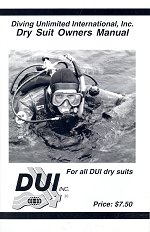Exposure Suits - Recommendations
The heavyweight cold-water wetsuit is probably responsible for the premature demise of more nascent diving careers than any other factor. These awful things are simply uncomfortable and ineffective. For all the stiffness, squeezing, bulk, and extra weight of 5-7mm wetsuit, in the end, it really doesn't keep you warm, and most cold-water wetsuit divers are pretty miserable creatures. I have seen the constriction and topside overheating of one of these things make its poor wearer sick on dry land, never mind on a boat out at sea.

For an excellent guide to drysuit use, pick up a copy of DUI's drysuit owner's manual, available at most dealers for under $10.
The argument that heavy cold-water wetsuits are easier to use is patently false. A wetsuit has a mind of its own and will make wide depth-dependant swings in buoyancy over which the wearer has no control. How is that better than a drysuit, which the user can consciously trim for constant buoyancy during the descent, and which semi-automatically trims itself during ascent?
My recommendation for someone just getting started is to get a good comfortable 3mm wetsuit or Polartec skin for the tropics, and initially restrict your diving to that. You will enjoy yourself, and become a better diver. When you are ready for local diving, don't buy a heavy wetsuit. Rent or borrow one for a few exploratory dives, to see if you really want to do this sort of thing. If you do, then save your money and get a drysuit. If not, then you will still have a good rig for the tropics, and you won't have lightened your wallet by $300 or more for a rubber straightjacket that you will soon not want.
My own cold-water kit consists of:
2 DUI front-entry crushed neoprene drysuits ( I long ago gave away my 7mm wetsuit ) with the old-style CF-200 boots, not RockBoots. One suit has a latex neck seal, the other has a neoprene; I have no real preference between the two. Both suits have long, heavyweight "industrial" latex wrist seals. Both suits have already seen a lot of heavy use ( one is a 1998, with over 300 dives on it, the other would have to be carbon-dated to know for sure ) and are holding up well in my opinion, with no more than expected maintenance ( seals, valves, zippers, small leaks, etc. )
In drysuit underwear, I started out with a nylon-shelled DUI Thinsulate jumpsuit, which wore out sooner than I would have hoped. I replaced it with a medium-weight nylon-shelled Polartec Andy's jumpsuit, which I have been much happier with. This is just about perfect by itself for most of the season. I also have a medium-weight DUI Polartec wooly-bear ( fuzzy green ) which I seldom wear because it is too warm. Colorful Polartec socks are thin and warm and can be layered up as needed. Lightweight Polartec skiing underwear ( tops & bottoms ) from Sports Authority provides extra under-layers in cold water.
Although it is rather expensive ( $60 vs. $40 ) I use a DUI warm-neck neoprene hood. My five-year-old one is still warmer than anything else I have ever used. In gloves, I use 6.5mm Kevlar-palmed Deep-See three-fingered mitts, all year, regardless of the temperature. ( Divers2 in Avon has them. ) With maintenance, I can make a pair of these last two or three years.
In the tropics:
I use a generic Polartec jumpsuit, mainly for protection from the sun. It is not as warm as a 3mm wetsuit, but more comfortable. I also use a thin pair of gloves for the same reason ( if they tell you can't wear gloves, tell them to go to hell. ) 6mm neoprene booties ( leftover from my wetsuit ) fill in the foot pockets of my fins, so I can use the same pair here or there. A Polartec suit like this can also be used as a drysuit underwear layer in a pinch.
Finally, whether you are in the tropics or off the coast here, the sun on the water will cook you fast. A broad-brimmed hat is essential to protect your face, ears, and neck. A baseball cap is not enough. Don't be afraid to wear long sleeves and sweat pants, and shoes, not sandals. Use lots of sunblock ( although I personally don't trust the stuff ) or better yet, keep to the shady side of the boat, or even inside.
DIR
The only acceptable DIR exposure suit seems to be a non-buoyant thin-shell drysuit. Buoyant wet and dry suits are discouraged because of the extra air and weight they require. If this is taken to mean only trilaminate suits, many of these are too fragile for wreck diving, although that situation has been improving. DIR discourages the use of ankle weights; I see no reason for that. I'm not sure how lace-up Rock Boots have escaped criticism from the DIR community, since they sure look like entanglement hazards to me.

